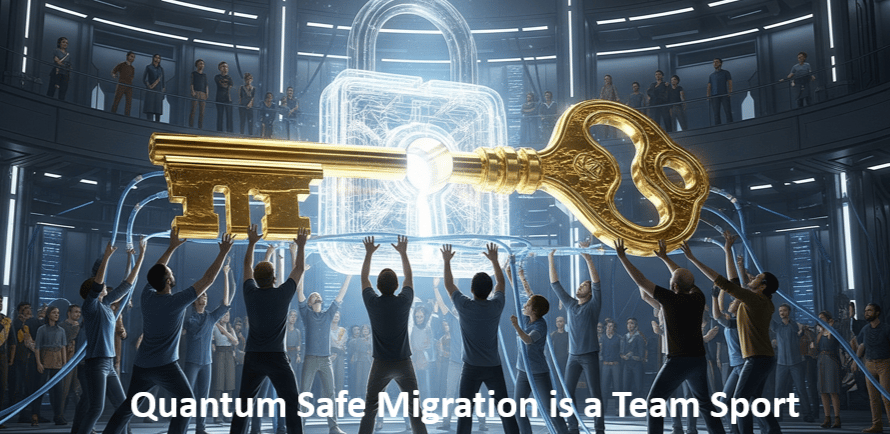Quantum-Safe Migration is a Team Sport — Why Your CISO Can’t Win Alone
Quantum-safe migration isn’t just a CISO’s job — it’s a cross-functional transformation. From executives and architects to developers, compliance, and vendors, every team plays a role in building true quantum resilience.
Gireesh Kumar N
8/13/20254 min read


The race to secure our digital future from quantum threats is no longer a distant concern — it’s a strategic priority. With the rise of quantum computing and the formalization of post-quantum cryptography standards, organizations must begin their quantum-safe migration journey today.
The looming quantum threat isn’t just a cybersecurity issue; it’s a business resilience challenge that demands cross-functional commitment.
But here’s the hard truth:
"The CISO alone cannot — and should not — fight this battle."
While the CISO may be the first to raise the flag and lead the transition, making an organization quantum-safe or quantum-resilient is not a just security project — it’s a cross-functional transformation. From engineering and product teams to compliance, operations, and the boardroom, every stakeholder has a role to play in making the organization quantum-safe and future-ready.
Let’s explore why.
1. Cryptography Is Embedded Everywhere
Cryptography powers authentication, confidentiality, integrity, and trust across nearly every digital asset in an organization. It is deeply embedded in:
Applications and microservices
Databases, APIs, and certificates
Cloud and on-premise infrastructure
Embedded systems and third-party software
Uarnveling these cryptographic dependencies — and replacing vulnerable algorithms like RSA, ECC, or DH — requires collaboration across business, development, and operations. No single team, including security, has full visibility.
2. Executive Sponsorship Is Essential
Quantum-safe migration is a strategic — not tactical — decision. It competes with other enterprise priorities for attention and funding.
The CEO, CIO, and CTO must treat quantum resilience as a long-term investment in digital trust
The Board must understand the systemic risk posed by quantum threat including “harvest now, decrypt later” attacks
Enterprise Architects must embed post-quantum and crypto agility principles into modernization roadmaps
Without CXO-level support, even the most well-intentioned security programs risk underfunding and reach inertia.
3. Product Management and Development Define the Future
Product managers and developers shape what customers will use tomorrow. If post-quantum cryptography (PQC) isn’t part of the roadmap, you’re building with insecure foundations.
These teams must:
Plan for crypto-agility and PQC integration
Evaluate performance impacts of larger keys and signatures
Collaborate with security and compliance
Ensure backward compatibility and customer trust
Quantum-safe design must start at the product specification stage, not as a security afterthought.
4. Enterprise Architecture Must Lead the Transition
Enterprise Architects play a pivotal role in shaping the technical migration blueprint:
Define crypto-agile patterns and hybrid models
Identify cryptographic dependencies across systems
Align PQC adoption with cloud, zero trust, and modernization/transformation initiatives
Future-proof systems for upcoming cryptographic shifts
They connect business strategy to execution — essential for any quantum-safe effort.
5. Developers and DevSecOps Must Rewire the Code
Post-quantum migration isn’t just a patch — it involves rethinking assumptions and rewriting code.
Discover cryptographic usage across codebases
Replace outdated crypto like RSA and ECC
Integrate PQC libraries (e.g., ML KEM/Kyber, ML DSA/Dilithium)
Test for performance, compatibility, and fallback
DevSecOps must now support continuous cryptographic lifecycle management.
6. Legal, Compliance, and Risk Functions Ensure Alignment
Quantum risk intersects with regulatory, contractual, and reputational domains:
Global standards and regulatory bodies have issued guidance
Long-term sensitive data (financial, health, national security) must be protected for decades
Contracts involving digital signatures and long-term confidentiality are at risk
Legal and compliance leaders must ensure the organization remains future-proof and audit-ready.
7. IT Infrastructure and Operations shape the Migration
Migration efforts ultimately take shape across infrastructure:
Define policies for organization IT for post quantum or hybrid cryptography use
Upgrade crypto libraries, modules, and hardware
Replace vulnerable certificates and protocols along with KMS, HSM and PKI systems
Deploy hybrid or post-quantum VPNs, TLS, SSH
Monitor and remediate legacy crypto usage
IT need to ensure changes are made securely and with minimal disruption.
8. Data Governance Must Protect Long-Lived Assets
Many organizations store data that must remain confidential or verifiable for 10–30+ years:
Financial records, healthcare data, IP, classified contracts
Data governance teams must:
Classify and prioritize long-lived sensitive data
Re-encrypt or re-sign using quantum safe cryptography
Align retention policies with post-quantum strategies
Without this, you're only protecting the surface.
9. Learning & Development Builds Organizational Readiness
Quantum-safe migration introduces new concepts, algorithms, protocols, and workflows — most teams aren’t prepared.
Training must span:
Executives and business leaders (strategic awareness)
Developers and architects (hands-on PQC implementation)
Security and infrastructure teams (governance and compliance)
Building internal capability is key to sustained progress.
10. Procurement and Vendor Management Drive External Alignment
Your quantum safety is only as strong as your vendor ecosystem.
Ask your vendors to share their quantum-safe roadmaps
Update RFPs to mandate crypto-agility and PQC readiness
Flag vendors relying on deprecated crypto
This is critical to supply chain security in a post-quantum world.
What’s the Path Forward?
Quantum-safe migration is a strategic transformation — not just a tech upgrade. Here's how organizations can act:
Form a cross-functional quantum task force
Inventory cryptographic assets
Perform quantum risk assessment
Engage executives and boards with tailored messaging
Train/upskill product, engineering, and DevSecOps teams
Integrate crypto agility and quantum safety into architecture and roadmaps
Update vendor and procurement requirements
Align data governance with long-term crypto needs
Monitor evolving standards and best practices
Build a phased migration roadmap with measurable KPIs
Promote a culture of crypto-readiness across the organization
Becoming quantum-safe is not a checkbox — it’s a journey. One that requires collaboration, commitment, and clarity across every function in the organization.
The CISO can lead, but only when everyone plays their part can true quantum resilience be achieved.
Ready to Begin? Start with AvinyaSQ QSM Ignite Starter Packs
Quantum-safe migration doesn’t have to be daunting. AvinyaSQ’s QSM Ignite Starter Packs are designed to help organizations take the first decisive steps toward quantum resilience — aligned with your current stage of readiness.
Each pack offers a structured combination of:
Executive and board briefings tailored to your context
Workshops and training for technical and functional teams
Cryptographic discovery and inventory
Quantum risk assessment and prioritization
Strategic Roadmap and planning for migration
PoCs/Pilots for PQC adoption
Advisory support for standards, strategy, and roadmap planning
Achieving quantum safety is not about one big leap — it’s about coordinated, strategic steps taken together across the organization. The sooner you start, the more control you’ll have over costs, timelines, and disruption. That’s why we created the AvinyaSQ QSM Ignite Starter Pack — a fast, practical way to mobilize your teams, assess your current risks, and build a clear migration roadmap in a calibrated manner.
Whether you’re aiming to raise awareness, get executive buy-in, or kick off your first risk assessment, the Starter Pack helps you move from uncertainty to action — before the quantum clock runs out.
📩 Contact us - Let’s talk about how we can help your organization become quantum ready — from boardroom to codebase.
